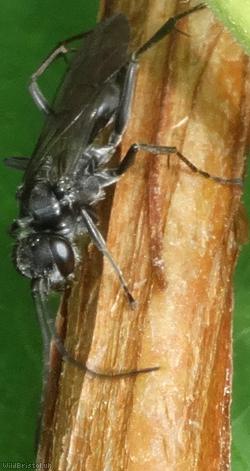Auplopus carbonarius - Auplopus carbonarius
Favourite Photos
Species Description
Scarce but not well recorded (I believe it is a lot more common then is stated because of its elusive nature). Exists South of the Wash. Habitat includes: woodland, streams, marshland. Flight period: June to August (but may be seen as early as May and as late as September). Dfference between Male and Female: Males have an Ivory coloured maculae (marking running between the lower half of the inner eye and the antennae) whereas the Females are dull black. The Male (8 mm) is also smaller than the Female (10 mm). Life story: The Female constructs nests with barrel shaped cells (normal around 10 but the record is 34) made out of mud (collected in pellets from damp areas, water is also collected to aid molding of the nest) in pre-existing holes in places such as beneath stones, masonry, tree stumps (old beetle burrows), under bark, crevices of tree trunks, empty galls (cynipid wasps), empty burrows of other invertebrates such as hymenopteran (Bees, wasps, Ants, Sawflies) Spiders are then foraged, paralysed, legs usually taken off, flown back to the nest and stuffed into the nest (1 in each cell) then an egg is laid in each. Diet: Adults = Nectar from Spurge, Larvae = Spiders (mainly from the Clubionidae family but Gnaphosidae, Salticidae, Agelenidae, Thomisidae, Lycosidae, Segestriidae, Anyphaenidae may also be used).





